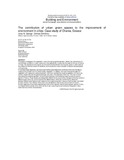| dc.contributor.author | Georgi, Neratzia Julia | |
| dc.contributor.author | Dimitriou, Dimos | |
| dc.date.accessioned | 2016-04-19T08:46:12Z | |
| dc.date.available | 2016-04-19T08:46:12Z | |
| dc.date.issued | 2010 | |
| dc.identifier.issn | 0360-1323 | |
| dc.identifier.uri | http://hdl.handle.net/11728/7501 | |
| dc.description.abstract | This paper investigates how vegetation, mainly through evapotranspiration, affects the improvement of
microclimatic conditions in urban areas and, more specifically, it examines the case for the city of Chania
in Crete. The objectives of this study are to examine the bioclimatic role of green areas in urban sites as
they affect the thermal comfort of residents, and to study the cross-correlation of factors that participate
in this process.
To achieve these objectives, we have examined the parameters that contribute to the microclimate of
a space and consider how it is influenced by vegetation. In addition, we have analyzed the effect of
vegetation with respect to evapotranspiration, and have recorded the existing vegetation of Chania city
and the relationship with the geomorphologic and urban characteristics of the city. This has involved
calculating the evapotranspiration of various plant species, and collecting measurements at various
places in Chania. These studies are designed to determine the cause of the changes of thermal comfort in
different parts of the city, and to examine the differentiation of thermal comfort that is observed
between different plant species with respect to the evapotranspiration measure that has been calculated
for each of them. The intention of this work is to aid efforts to improve the environment of Chania
through better planning and the appropriate choice of the species used for planting open spaces. Finally,
it is hoped that the results of this work will be of use in planning the environments of spaces in other
cities that have similar characteristics. | en_UK |
| dc.language.iso | en | en_UK |
| dc.publisher | Elsevier | en_UK |
| dc.relation.ispartofseries | Building and Environment;vol. 45 (2010) | |
| dc.rights | 2009 Elsevier Ltd. All rights reserved. | en_UK |
| dc.rights.uri | http://creativecommons.org/licenses/by-nc-nd/4.0/ | en_UK |
| dc.subject | Research Subject Categories::FORESTRY, AGRICULTURAL SCIENCES and LANDSCAPE PLANNING | en_UK |
| dc.subject | Urban climate | en_UK |
| dc.subject | Evapotranspiration | en_UK |
| dc.subject | Discomfort index | en_UK |
| dc.subject | Crop coefficient | en_UK |
| dc.title | The contribution of urban green spaces to the improvement of environment in cities: Case study of Chania, Greece | en_UK |
| dc.type | Article | en_UK |
| dc.doi | 10.1016/j.buildenv.2009.12.003 | en_UK |


